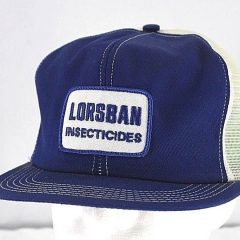Search results for “pesticide residues”:
The EPA has made its last play in a long game of regulatory tug of war regarding the controversial insecticide chlorpyrifos, as the New York Times reports. The epic legal battle unfolded after President Obama initially banned the use of chlorpyrifos in 2015 due to concerns that even low exposures caused neurodevelopmental impacts in children. […]
Read More, References, Comment »
Page A20 of the June 11, 2019 Wall Street Journal is a full page “Roundup is safe” advertisement by Bayer. It begins — “Tested for 40 years. Approved for 40 years. Used safely for 40 years.” We’ve posted an image snapped with an iPhone from our copy of the WSJ at the bottom of the post […]
Read More, References, Comment »
Ever wonder about the impact of heavy, year-to-year applications of glyphosate-based herbicides on wildlife and ecosystem food chains? Environmental Health News provides some key, fresh insights in “What’s the world’s most widely used herbicide doing to tiny critters?” We already know that glyphosate and other pesticides have become ubiquitous in streams and groundwater, suggesting ecological impacts are likely […]
Read More, References, Comment »
The California chapter of the consumer-interest group U.S. PIRG recently tested 20 popular brands of beer and wine for glyphosate residues, and the report of their findings is attracting some attention. Ninety-five percent, or 19 out of 20, of the products sampled had measurable glyphosate, with concentrations ranging from trace amounts to 51 parts per […]
Read More, References, Comment »
After months of meetings, and over 2,500 public comments, the Arkansas Plant Board finally decided what to do about dicamba in the 2019 planting season. As Liza Gross reports in Fern’s Ag Insider, The Board went against the recommendations of state weed scientists, and the vast majority of the members of the public who provided […]
Read More, References, Comment »
Two years ago in 2017, scientists with the USGS and the University of Iowa first reported that neonicotinoid insecticides were “persistent” in drinking water samples collected at the University’s Iowa City campus during a seven week period after the corn planting season (May-July). The reason why was no mystery — at least 80% of the GMO […]
Read More, References, Comment »
Introduction Three Major Actions The Food Quality Protection Act (FQPA) Glyphosate/Roundup Case Study The Lowdown on Roundup Changes Over Time Does Glyphosate/Roundup Cause Cancer IARC vs. EPA Genotoxicity Paper Introduction Pesticide regulators strive to prevent “unreasonable adverse effects on man and the environment,” the basic standard embedded in the FIFRA statute (the Federal Insecticide, Fungicide, […]
The results are in on one of the first, large-scale studies on organic food consumption and cancer risks and they are significant and encouraging. It is widely recognized we need to do much more in preventing cancer, as opposed to treating it, and this study suggests that organic food may be an important piece of […]
Read More, References, Comment »
First, the back story. Over the years, the USDA has almost always sided with pesticide manufacturers and farmers, in opposition to EPA efforts to curtail or end the use of high-risk pesticides. The arguments advanced by the USDA are always basically the same: There are no viable alternatives to this pesticide. Consumers will face food […]
Read More, References, Comment »
Genetically engineered (GE) corn and cotton expressing Bt toxins for insect control came on the market in 1996. The most contentious public policy and regulatory issue prior to approval was whether and how the biotech-seed companies should prevent the emergence and spread of insects newly resistant to Bt toxins. For more on the debate over […]
Read More, References, Comment »









